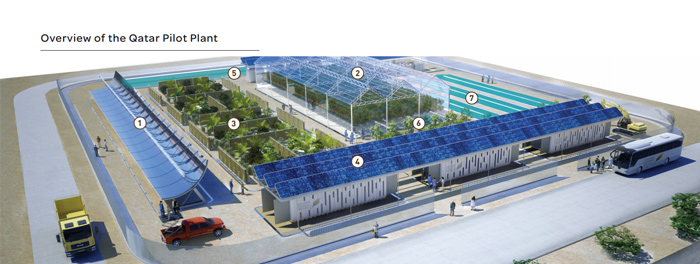In December I wrote about the need to invest in a basket of integrated solar technologies with truly vast potential. Today I want to write about just one project that has transformed one hectare of unproductive desert in Qatar into a wonderfully productive focus of these new and exciting synergistic technologies. This one hectare now produces food, energy and water in ways that exemplify carbon negative, biodiversity increasing, truly sustainable economic growth.
Construction began in February 2012 and was completed in December 2012, just in time to serve cucumbers to visitors from the nearby UN Doha Climate talks, and so hopefully inspire leaders as to the potential sustainable productivity of the world’s deserts and their key role in helping tackle climate change.
The Qatar Project has been instigated by the Norwegian Sahara Forest Project with a wide variety of partners and collaborators. The above diagram highlights the seven key features of the Qatar Project. All these seven technologies have vast synergistic benefits, and are being developed and monitored in this pilot facility with a view to larger scale rollout, with the next stage probably being a much larger facility in Jordan.
1, Concentrating Solar Power, parabolic trough reflectors are used to generate heat, which is used primarily for desalination.
2, Saltwater Greenhouses. A development on the Seawater Greenhouse, using sophisticated solar powered evaporative cooling technologies to produce high value food crops with minimal water and energy requirements.
3, Outside vegetation and evaporative hedges. Many species of plants are trialled as food, fodder or bio-energy crops, for carbon sequestration and to help remove dust from the air, so helping protect the efficient working of the various forms of solar power. The evaporative hedges act to further concentrate the brine ready for salt production (5) and as windbreaks to create good growing microclimates.
4, Photovoltaic Solar Power
5, Salt Production finished in evaporation ponds.
6, Halophytes. Salt-loving plants, which have great potential for many uses and are well suited to be grown in deserts, are cultivated in ways that ensure salt does not enter the soil or aquifers.
7, Algae Production. Vast potential for medicine, food, fodder, biofuel, soil enhancement.
Lots more info on the Sahara Forest Projects website: http://saharaforestproject.com/


